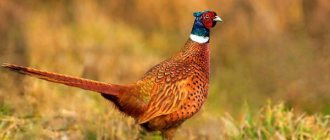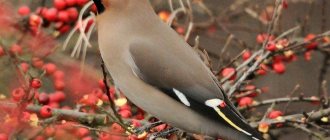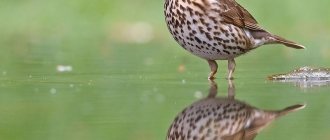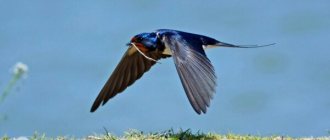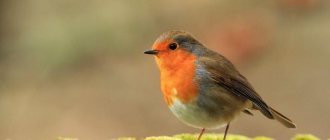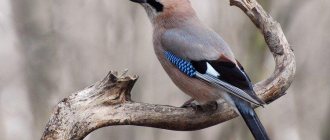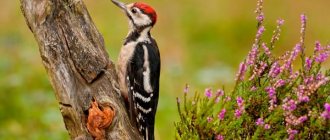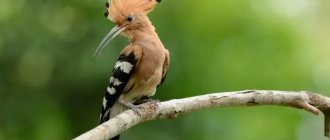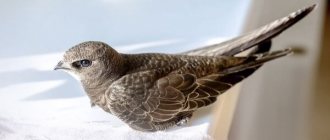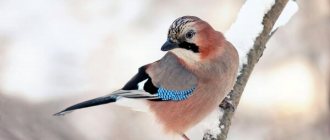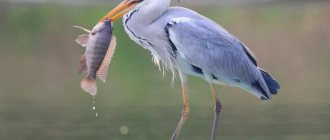Tit bird - general description of the species
The bird that most people call a tit is a specific species - the great tit. And it includes about fifteen subspecies. They differ both in appearance and habitat.
Great tit
Why is it called that?
One of the questions that occupies people interested in birds is why the tit was called the tit. After all, the name clearly refers to the color blue. And the most noticeable part of the bird is its yellow chest and abdomen.
There are two versions, and each looks quite plausible.
On the one hand, the origin of the name may be associated with the singing of birds. It most closely resembles the repetition of the words “xin-xin.” It is not surprising that with such singing the bird received the appropriate name.
Curious! Of all the forests, tits prefer oak forests - there are always many hollows where you can build a nest.
On the other hand, there is a version that the tit was originally called the common blue tit - today it is one of one and a half birds included in the genus of tits. Her back and upper part of her head really have an attractive light blue color, which very elegantly complements the yellow chest and abdomen.
Hand bird
Few people know what the people call the tit. She has the nickname "nine-word". From what? Today it is difficult to answer this question. It was believed that the tiny bird greeted spring with its trills, saying goodbye to winter. But even experts don’t know how this relates to her nickname.
Diversity
The genus of tits includes fifteen subspecies, but relatively recently there were seventeen of them. Fortunately, this is not associated with the extinction of rare birds. It’s just that the gray tit and the eastern tit were identified as separate species.
Migratory or wintering bird
People are also often interested in whether the tit is a migratory bird or not. After all, you can see tits quite often in winter, but almost never in summer. In fact, it only migrates a little, changing its habitat. The beak of these birds is primarily adapted for hunting insects, which cannot be found in winter. But they don’t know how to stockpile like some other birds. But a solution to the tit problem was finally found.
In the warm season, they live in forests, undergrowth and even mountains. But they fly to people for the winter. Some bird lovers install special feeders to please these cheerful fidgets. But even if you don’t do this, people produce quite a lot of waste, which tits enjoy feasting on.
Why are tits considered maniacal dismemberers?
The diet of these birds includes various insects: caterpillars, beetles, aphids, bees and many others. Tits can also eat plant seeds. But few people know that these birds are real predators. They hunt smaller birds, rodents, and bats. Tits often attack their own kind. They choose weakened individuals. These birds kill for one purpose - to enjoy the taste of the victim's brain. They break through her skull with their sharp beak and peck out the organ of interest to them.
So tits can be fed not only with seeds. A piece of lard can also satisfy their hunger. Remember this when you get ready for a walk in the park.
Description of the bird, difference
It is problematic to describe each of the subspecies - I would have to write a whole article just on this topic. It’s better to figure out what the great tit looks like - the most common and famous.
Male
Although the bird itself is quite small, about the size of a sparrow, its long tail makes it look larger. The body length of males reaches 17 cm and weighs 21 g. The wingspan can reach 26 cm.
Interesting fact! Many times there have been recorded cases of tits pecking at the foil caps on bottles of cream. Moreover, they easily distinguished them from milk bottles by the color of the caps.
A description of a tit would be incomplete without mentioning its color. Her chest is bright yellow, and the elegant black stripe that runs from chest to rump looks like a chic tie. The cheeks are white, the back of the head is decorated with a whitish-yellow spot, and the top of the head is covered with black feathers.
What does a female tit bird look like?
In general, it is similar to males - there are no such sharp differences as, for example, in the bullfinch. Females are slightly smaller than males, and their color is not so bright. The chest and head are not black, but rather dark gray. In addition, the stripe on the wings is not greenish-blue, but greenish-gray.
How is a female different from a male?
Everyone instantly recognizes this bird by its bright plumage - a yellow chest with an unusual grayish or black pattern, reminiscent of a tie. But few people know that it is by color that one can distinguish a male from a female. The fact is that the female’s plumage color is duller than the male’s.
But it’s unlikely to be possible to distinguish birds by size. Since individuals of both sexes have the same average parameters - height from 13 centimeters, weight from 14 to 20 grams, and a wingspan of up to 27 centimeters.
Distribution, habitat
The great tit's habitat is quite vast - almost all of Europe (with the exception of Scandinavia), as well as Asia - from Central Asia to the Far East. You can also see such birds in Africa - mainly in its northeastern part.
Temperamental birds can fight
Birds do not like to sit in one place for a long time, often migrating from place to place, looking for more nourishing places. But they try not to venture into dark forests, preferring to live on the edges, open areas, as well as along the banks of lakes and rivers. It is relatively rare for birds to settle far from human habitation, weaving nests 10-15 km away.
How does a male court his darling?
Tits create monogamous families, that is, they choose one partner for a fairly long period of time. The courtship period begins from late January to September. But due to the early arrival of heat in some regions, it may begin earlier. It is at this time that food appears for future offspring. Basically, these are caterpillars. The process of courtship itself resembles more of a kind of ritual - the male, having fluffed out his wings and tail, easily plows from branch to branch, and then heads to the place where the nest will soon appear and feeds his “bride” in a special way.
Lifestyle
To form a more complete opinion about the birds of the tit family, you should also understand smaller but important details.
How long do tits live?
In the wild, the life expectancy of a tit is very short - on average it ranges from 1 to 3 years. And this is if she can survive the difficult period of learning to fly and the first winter - the hardest.
This is interesting! Unlike pigeons, sparrows and other birds, tits never drink from puddles, preferring exclusively clean water.
But if properly kept in a cage, the same titmouse can live much longer - scientists have repeatedly recorded a life expectancy of 10 and even 15 years. According to the most conservative estimates, a bird lives 3-5 times longer in captivity than in the wild. Therefore, people who believe that animals should live only in the wild should sometimes remember how long tits live in the forest and in a cage.
What does a tit eat?
The basis of their diet is insects. Moreover, the birds do not make any special distinctions, successfully pecking at worms, flies, ants, mosquitoes, cockroaches, spiders, butterflies, dragonflies and many other invertebrates found in their habitats. But they prefer to feed the chicks only with small caterpillars - they do not have hard chitinous body parts, which makes them easy to digest.
With the arrival of autumn and the first frosts, the number of insects decreases sharply. Birds have to significantly change their diet in order not to starve. They switch to seeds - less calorie, but more affordable food. Tits peck hazel and beech seeds, also not disdaining oats, corn, wheat and other grains. Among forest plants they prefer rowan, shadberry, maple, spruce, horse burdock and many others.
Note! These birds do not disdain carrion - they can often be seen on the carcasses of dead ungulates.
White tits and Muscovites stock up for the winter by hiding seeds in secluded places so they can have a snack on cold days. The great tit does not have such a habit, but it is very good at finding reserves of Muscovy and happily feasts on them.
Reproduction when chicks are hatched
Depending on the climate, the breeding season for these birds shifts significantly - from late January to early September. It all depends on the temperature and availability of food. In southern Russia and Ukraine this is mid-February, and in more northern regions - later.
Moreover, very often two clutches are made per year - one at the very beginning of the thaw, and the second at the beginning of summer. The number of eggs varies greatly - on average from 5 to 12. They are hatched exclusively by the female, but at this time the male takes care of his girlfriend, bringing plenty of food.
What does a nest look like?
When building a nest, all the work falls on the shoulders of the female. Unlike most birds, true tits prefer to build nests in places that are difficult for predators to reach - hollows, rock crevices. In St. Petersburg, a case was even recorded when birds made a nest in the barrel of a cannon.
In the wild, animal fur, bird feathers, insect cocoons and other soft objects are used. If construction is carried out close to human habitation, then threads, cotton wool and other soft debris are also used.
How many chicks are born?
Tits lay eggs twice. The first time - in April - May, and the second time - in June. Hatching of eggs lasts approximately 12-14 days. In the first clutch there are 5-12 of them, and in the second there are two fewer eggs. Until the moment the chicks are born, the male obtains food for himself and his partner. The chicks from the first batch live with their parents for 22 days, after which they learn to fly. During the entire training period they still live with mom and dad. The chicks from the second batch live with them much longer - up to 50 days. In total, these birds live about 15 years.
Keeping at home
Some people like the appearance and behavior of tits so much that they decide to tame them and keep them at home in a cage.
What to feed
The most important requirement that must be met when keeping birds at home is a proper, balanced diet. It is best to give a daily mixture consisting of equal parts:
- minced meat;
- grated carrots;
- white crackers;
- cottage cheese.
This combination of proteins, fats, carbohydrates and vitamins allows the bird to live the entire allotted period - which is 10 years or even more.
Mealworms
Also, experts who know about the habits of tits recommend giving them mealworms. You can buy them at a pet store or even breed them at home. Three to five of these worms a day will make the bird’s life happier.
Breeding and care
It is relatively difficult to obtain offspring from tits - you will need a fairly large aviary dedicated to two birds. During this period, feeding should be especially plentiful; it is advisable to increase the amount of live food in the diet. Then the tits will be sure that spring has come, and there will be no problems with feeding the chicks.
On a note! In summer, a tit eats about the same amount of insects per day as it weighs.
Moreover, you need to carefully monitor their behavior - tits have a very difficult character, and a male and a female can start a fight. In this case, they need to be seated for several days, and then try again. If the male sings trills and the female listens to them favorably, then everything is going as it should.
Birds do not need special care at this time. It is enough to give them fresh food and clean water, and at the same time put a small house or a closed box with a narrow opening, and spread threads and wool around the cage so that the female has something to build a nest from. In just a few weeks, the birds will delight the breeder with a new addition to the family.
Reproduction and offspring
Great tits (Bolshaki) in our country have quite large populations. These are monogamous birds that form pairs, after which they begin to form a nest. The female and male raise their offspring together. To build their nests, they choose light forests, where deciduous trees predominate, growing in the coastal zone, in gardens and parks. Coniferous areas are not suitable for nesting of these birds. A tit's nest can be located anywhere, including in niches of old buildings or in the hollows of old trees. Often tits occupy old nests abandoned by other birds at heights from 2 to 6 meters. Tits can easily settle in man-made buildings equipped for nesting.
To build a nest for themselves, birds collect and bring small blades of grass or twigs, roots of various plants, including moss. The inside of the nest is made softer and warmer, so the birds cover it with wool, cobwebs, cotton wool, down and feathers, and a small depression is made in the center of the nest, which is covered with horsehair or wool. Depending on the habitat, the size of the nest may vary, but the difference is very slight. Therefore, the average dimensions of the internal part range from 40 to 50 mm. In this case, external dimensions range from 40 to 60 mm.
The titmouse lays up to 15 white eggs. Spots and dots of a reddish-brown hue are scattered in a chaotic manner across the entire surface of the shell. Great tits breed up to 2 times a year. The first offspring appears around the end of April, and the second around mid-summer.
The female incubates the eggs for about 2 weeks maximum, and the male feeds the future “mother” all this time. After the chicks are born, the female warms them with her body heat for the first two days, since the body of the chicks is barely covered with grayish fluff.
During this period, the male has to feed not only the female, but also the chicks. After something like feathers appear on the chicks’ bodies, the female leaves the nest, and they begin to feed the future offspring together. During the growth period, the chicks eat quite a lot, so their parents barely have time to catch insects, bugs, caterpillars, etc. for them.
Interesting fact! During the mating season, tits are highly aggressive towards each other.
After about a couple of weeks, the chicks are completely covered with feathers and are ready to get their own food. For about a week, the chicks still remain near their nest, and their parents continue to feed them. Young animals will become fully sexually mature closer to the first year of their life.
TITMS
And again about the birds. In this post you will learn a lot about titmice. For example, why are they called “titmouse” if they are not blue.
Tits are omnivores, and their muscle strength is very strong for animals of their size.
In the cells of their muscles, as in all cells, there is an improved metabolism. (In a number of organs, isolated mitochondria consume 3 times more oxygen, while the mitochondria produce only one third of the amount of hydrogen peroxide required for mammals. In addition, birds have very high cellular resistance to oxygen damage). All this allows them to have a metabolic rate tens of times higher than that of mammals (even their size), more efficient functioning of all organs and a longer life expectancy. Tits are stronger than they should be for their size. And this is not only because they belong to the class of birds called cellular aromophoses, and to the most adaptive group - the passerines. Tits, even among birds, are distinguished by their developed muscles; the force of the blow with their beak allows them to lay out acorns. During hungry winter times, they also use it for hunting. There are places where the habitats of tits and bats overlap. Chiropterans did not give rise to such a large branching into orders and did not become apex predators in their environments, as mammals managed to do on land and in water. They occupied only a very specialized niche, hunting insects at night to avoid competition with insectivorous birds. During the day they hide from them in caves, but tits are smart and quickly learned to find them there
The character and lifestyle of the tit
A bird that just can't sit still. They are constantly on the move. tit and its features are interesting.
consist of uniting grown-up chicks in the fall together with their parents and other families into small flocks, about 50 birds in total.
The little bird accepts everyone into its flock. You can even see birds of other species together with them, for example.
But only a few of them will survive until spring, dying of hunger. But these are real orderlies of forests and gardens. During the summer they eat so many harmful insects. Just one pair of tits, which feeds their offspring, protects up to 40 trees in the garden from pests.
Only during the mating season will the flock split into pairs and clearly divide the feeding territory, which is approximately 50 meters.
During the period of feeding the young, a cheerful and lively bird turns into angry and aggressive creatures, driving out all competitors from its territory.
What is the best way to feed tits?
As for the set of feeds, the Russian Bird Conservation Union for tits and other insectivores recommends unsalted lard of any animal, unroasted sunflower seeds (they are very high in calories) and pumpkin (to a lesser extent - watermelon seeds, melon seeds and white bread crumbs). They do not eat traditional millet or waste gray bread.
Interesting materials:
What is the name of the place where bees are kept? What is the name of the place where the magnetic field is strongest? What is the name of the place where you can look at the stars? What is the name of the place where the horses are? What is the name of the place where Web pages are combined? What is the name of the place where the horse racing takes place? What is the name of the place where gladiator fights were held? What is the name of the place where fish are raised? What is the name of the place where wolves sleep? What is the name of the place where spaceships launch?
